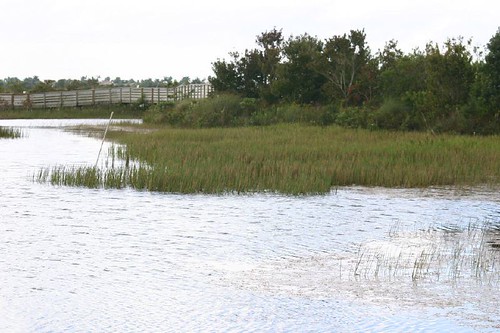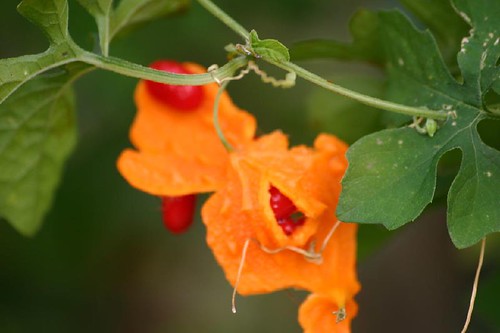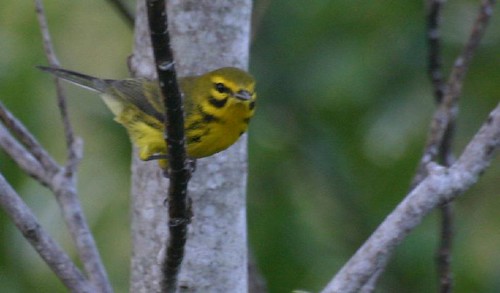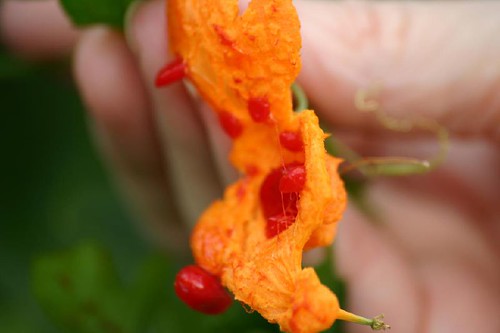In mid-October, we visited nearby Chapel Trail Nature Center in Pembroke Pines, FL. It is a peaceful bit of restored Everglades, surrounded by development that is picking up pace. The outer extent of the boardwalk was overturned by Hurricane Wilma, but beautifully repaired, with minimal damage to the wetlands. The storm felled all the big snags that had been used by Bald Eagles and other raptors. 
The area is most interesting during both spring and (especially) fall migration. During past visits we have seen Limpkins, American Bitterns, Swamp Sparrows and Marsh Wrens. Exotic Purple Swamphens had extended their range into the area during the past year, but probably were gunned down in the extermination program. Several Common Yellowthroats and Carolina Wrens were about. This Prairie Warbler approached us closely.
A Magnolia Warbler eluded us for quite awhile, but finally emerged for this shot. So far, we had seen nothing out of the ordinary. After we walked the length of the boardwalk and started back, something caught my eye.
Next to the boardwalk, a vine with yellow flowers was winding its way through the branches of a tree that had red berries.

Suddenly, I was surprised to see something very unusual, or so I thought at the time. One of the flowers on that same vine looked as if it had gobbled up some of the berries and appeared to be engulfing and absorbing them! Its petals were swollen and turning orange, perhaps from the red color of the juice of the hapless berries it had engorged. A vegetarian plant? Wow! I had never heard of such a thing. Of course, I snapped a few photos for posterity– was this incident new to science, and never to be seen again?

I looked more closely. Indeed, some of the red berries appeared to be partially digested. A gruesome sight!
Back home, I turned to the Internet, Googling such search terms as “plant eating plant, berry-eating flower, frugivorus efflorescence…” all to no avail. The flower had to be some sort of alien (possibly from this planet), so I scrolled through pictures of introduced and invasive Florida vines. Sure enough, I found an exact match at this link: in KILLER PLANTS.COM — by golly, someone else had already discovered it, and my photo would not make me famous after all. It had even been featured as the Killer Plant of the Week in September, 2004. Read on:
“The bitter melon or balsam pear (Momordica charantia Linnaeus) is a cucurbit, a member of the Cucurbitaceae. Native to the Old World tropics, it was introduced and has naturalized throughout the subtropics and tropics worldwide. Balsam pear was probably introduced to the Caribbean and Florida by slaves brought from Africa for the sugar plantations.
“Each node along the vine has a deeply lobed leaf and a tendril. Like other cucurbits, bitter melon is monoecious bearing staminate (male) and pistillate (female) flowers in the axils of the leaves. Bees are the primary pollinators. After pollination, a small fleshy gourd forms. When ripe, the gourd turns yellow and splits exposing the red aril-covered seeds“ (My emphasis; according to Wikipedia, an aril is a fleshy covering of certain seeds formed from the attachment point of the seed).
“The immature gourds, those that have not turned yellow, are used in Asian cooking. They are an excellent source of vitamins A and C, iron, and carbohydrates. But long ago in Africa, India, and China, the leaves and ripe gourds of bitter melon joined those plants found useful as medicines.
“In Jamaica, a tea of ‘cerasee’ leaves is said to improve “bad blood” and ease gripes (spasmodic pains of the large intestine). In Ayurvedic medicine, ‘karela’ fruit is considered ‘cooling’ and provides a treatment for anemia and other blood disorders, stomach problems like ulcers, upset stomach, and lack of appetite, asthma, bronchitis, and fever. In traditional Chinese medicine, ‘fu gua’ is used as a hypoglycemic agent (reduces blood sugar levels).
“Bitter melon is currently under study as a complementary drug in the treatment of diabetes both to reduce glucose levels and oxidative stress (antioxidant), as an antiviral therapy for HIV infection, and as a cytostatic (stops cell growth) in certain cancers.
“But bitter melon is not for self-medicating. It is contraindicated in many people. Its blood glucose lowering ability has caused comas in people prone to hypoglycemia. Taken with a stimulant laxative, it can cause severe potassium depletion. The seeds are toxic causing vomiting and diarrhea; death can occur especially in children. It is an abortifacient and should be avoided by pregnant women. It contains vicine and causes favism [anemia caused by hemolysis or the destruction of healthy erythrocytes (red blood cells)] in people who have a variant glucose-6-phosphate dehydrogenase. (See Plants that Changed History, October 7, 2003) And the drug reduces fertility in both men and women.”















